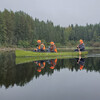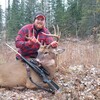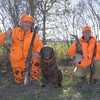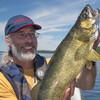
James Smedley's 11th-Hour Deer

“Let’s hunt till noon,” I text my hunting partner, Gord Ellis, who is hunkered down in a ground blind 500 metres away over the rise of a hill. I'm in a ground blind along the wooded edge of an open field east of Thunder Bay. It’s a cool, overcast, mid-November morning. Although in the final stretch of my hunt, I’m still hopeful. I keep careful watch over the rolling grassy field, occasionally scanning the bush line with binoculars to a corner where Gord has sweetened the property with a pile of grain and apples. An animal could appear at any moment.
Over the last few days, I’ve spent hours gazing out at this mix of bush and clearings. One evening, a mature animal walked across the field, well out of range and partially obscured by a dip in the rolling landscape. I also spent a day hunting a bush lot east of the city with Gord’s dad, Gord Ellis Sr. That day was marked by relentless pouring rain and the sound of a deer approaching my soggy hiding place from behind, then huffing and running off unseen.
This morning is my last attempt, and although I’m in no hurry to stop hunting, I decide that quitting by noon would enable me to get back to my home by suppertime. At about 9 am, there is clearly an animal walking around in the woods nearby, but it never shows. By 10:30, I’m contemplating packing up and starting my six-hour journey home, but I continue to glass the field and bush line. When noon rolls around, I reluctantly accept that my hunt is over, pop the slug from my 12-gauge, stow my rangefinder, and collapse my shooting stick.
A text from Gord says he’s waiting for me in the truck. I crawl out of the blind and work my cramped muscles with a short jaunt along the bush line. While stretching my arms up into the air my peripheral vision picks up something out in the field. I slowly turn my head to see a large doe about 400 yards away, working her way toward me. Standing out in the open I fully expect to be spotted, but each time she stoops to munch on grass I take a step towards the blind. Eventually, I make it back to my hiding place, reload and text my partner, “there’s a deer in the field.” By the time I raise my rangefinder, she is within 60 yards and closing. I shoulder my shotgun and squeeze the trigger.

Gord arrives shortly after to help field dress and load the 11th-hour doe into my truck, and I’m on the road only slightly behind schedule.
Thunder Bay area has a potent mix of thick forest interspersed with agricultural fields that supports a healthy population of whitetail deer. Flanked by deer country and loaded with accommodation options, the city of Thunder Bay is a productive Northwestern Ontario deer hunting destination.
Recommended Articles

How to hunt black bears
Hunting with The Wind
Big Bears
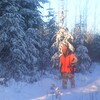
Stalking Late Bucks

Ground Blind Hunting

Wild Game Venison for the Home Smoker
Turkey Hunting Tips

Cast and Blast

Techniques for an Ontario Moose Hunt

The Northern Ontario Moose Hunt
Algoma Country Grouse - Exploring a New Region to Hunt
